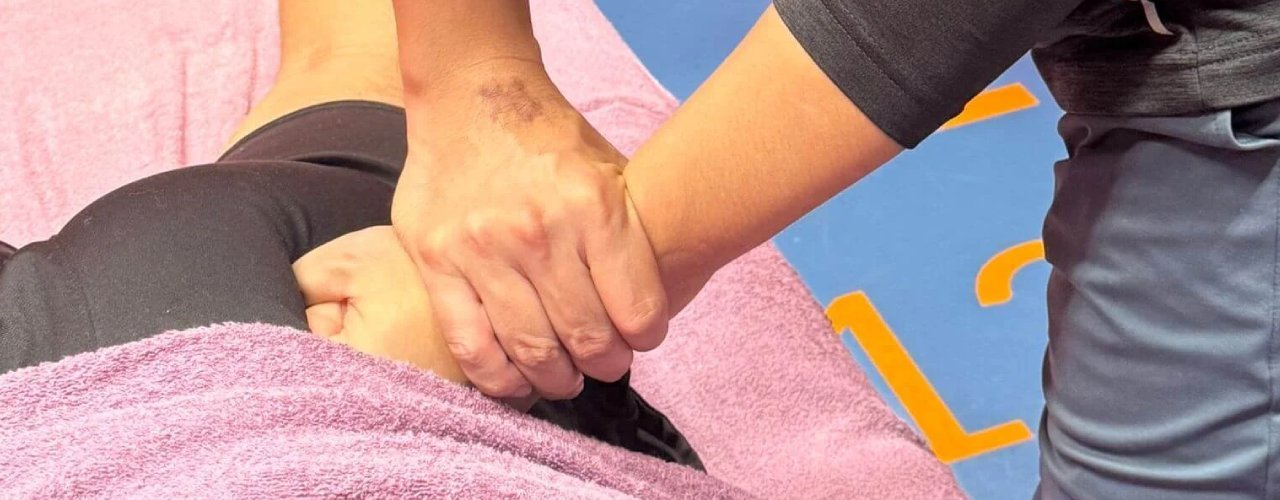
Mastering Compression Techniques: Enhancing Performance & Recovery
is designed for sports therapists, athletic trainers, sports injury and recovery professionals and fitness enthusiasts who want to enhance their skills in compression techniques. The course focuses on the application of manual compression techniques to improve athletic performance, accelerate recovery, and prevent injuries.
The aim of this course is to equip participants with manual compression techniques to enhance athletic performance, accelerate recovery, and support injury recovery. Participants will gain hands-on skills, theoretical knowledge, and practical strategies to effectively integrate compression techniques into their practice, ensuring optimal outcomes for their clients.
Importance in Sports Performance and Recovery
In the high-pressure world of sports, every second counts. Compression Techniques helps athletes recover faster, perform better, and stay injury-free. By understanding and applying these techniques, sports therapists and its practitioners can play a pivotal role in an athlete’s success, ensuring they remain at peak performance while minimizing downtime due to injuries.
INSIGHTS
- Compression techniques is a cornerstone of sports recovery, offering immediate and long-term benefits for athletes
- Broaden your client services with this great addition to your Personal Trainer Certification
- Perfect for sports therapists, athletic trainers, sports injury and recovery professionals, and fitness enthusiasts
- Eligible for UTAP claims
- Upcoming Intake:
24-25 January 2026
- Course fee:
Early Bird: S$629 (ends 31st Dec)
Regular Price: S$699
Group S$599 (Minumum 3 pax)

WHAT YOU WILL LEARN:
Participants will gain hands-on experience in applying palm, thumb, forearm, elbow (localised region) compression and dynamic compression to key muscle groups. The course covers the science behind compression techniques, including its effects on blood flow, lymphatic drainage, and muscle tension.
WHy IT MATTERS:
Compression techniques is a cornerstone of sports recovery, offering immediate and long-term benefits for athletes. It reduces muscle soreness, enhances recovery, and improves performance by optimizing circulation and reducing inflammation. Mastering these techniques is essential for providing effective, evidence-based care that supports athletes’ physical demands and recovery needs.
LEARNING OBJECTIVES
- Understand the Science of Compression Techniques
- Explain the physiological effects of manual compression on blood flow, lymphatic drainage, and muscle recovery
- Describe how manual compression reduces inflammation, muscle soreness, and delayed onset muscle soreness (DOMS)
- Master Manual Compression Techniques
- Demonstrate proper hand placement, pressure application, and body mechanics for effective palm compression
- Practice compression techniques on major muscle groups, including quadriceps, hamstrings, calves, shoulders, back and arms
- Integrate Compression Techniques into Sports Recovery
- Use manual compression to support injury recovery, including managing swelling, improving range of motion, and promoting tissue healing
- Adapt compression methods for acute and chronic injuries, ensuring safe and effective application
- Enhance Mobility and Reduce Tension
- Perform dynamic compression techniques to improve mobility and reduce muscle tightness
- Combine compression with stretching and movement for enhanced therapeutic effects
- Assess and Monitor Client Progress
- Evaluate the effectiveness of manual compression techniques through client feedback and objective measures (e.g., ROM, reduced pain, improved mobility)
- Adjust techniques based on individual client needs and responses
- Ensure Safety and Best Practices
- Identify contraindications for manual compression techniques (e.g., acute injuries, open wounds, or infections)
- Follow ethical and professional guidelines when applying compression techniques
- Develop Hands-On Proficiency
- Participate in supervised practice sessions to refine manual compression techniques
- Receive feedback from instructors to improve accuracy, pressure, and client comfort
Affiliations:
Clinical Orthopaedic Manual Therapy (COMT) certification
LearnMuscles Continuing Education (LMCE) online education portal


1-Day Course Outline
09:00AM – 09:30AM: Welcome and Introduction
09:30AM – 10:30AM: Science of Compression Techniques
10:30AM – 10:45AM: Morning Break
10:45AM – 12:15PM: Manual Compression Techniques
12:15 PM – 1:15 PM: Lunch Break
1:15 PM – 2:45 PM: Manual Compression Techniques
2:45 PM – 3:00 PM: Afternoon Break
3:00 PM – 4:30 PM: Compression in Injury Recovery
4:30 PM – 5:30 PM: Advanced Techniques and Integration
5:30 PM – 6:00 PM: Recap, Q&A, and Certification
2-Day Course Outline
09:00AM – 09:30AM: Welcome and Introduction
9:00 AM – 10:30 AM: Manual Compression Techniques: Upper Body Back
10:30 AM – 10:45 AM: Morning Break
10:45 AM – 12:15 PM: Manual Compression Techniques: Arms
12:15 PM – 1:15 PM: Lunch Break
1:15 PM – 2:45 PM: Manual Compression Techniques
1:15 PM – 2:45 PM: Advanced Techniques and Integration
2:45 PM – 3:00 PM: Afternoon Break
3:00 PM – 5.30 PM: Final Review and Practical Applications
5:30 PM – 6:00 PM: Certification and Closing Remarks

EDUCATOR
With a combined industry experience of 25 years in the therapy, fitness and sports education field, Edufit assures quality training for participants. The 20% theory, 80% practical approach aims to help participants gain the most out of hands on skills practice.
Edufit trainers are trained and certified in multiple disciplines such as MSc Exercise and Sports, B.Sc Ex Sports Sc, BSc App (Hon) Human Movement, Dip. Osteopathic Articulation, ITEC UK Lvl 3 Therapist and other certifications from COMT, ACSM, ACE, NASM, SMA, KT Tape, Rock Tape.





